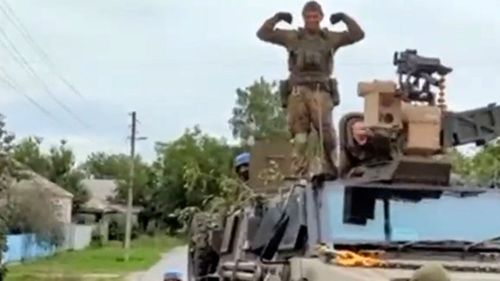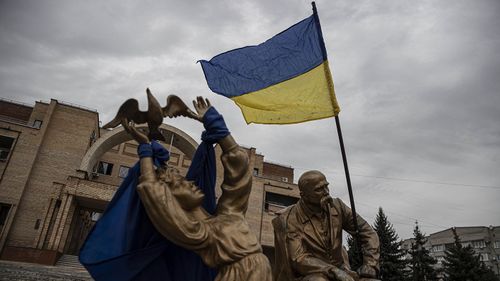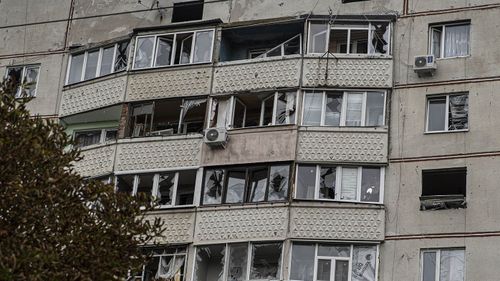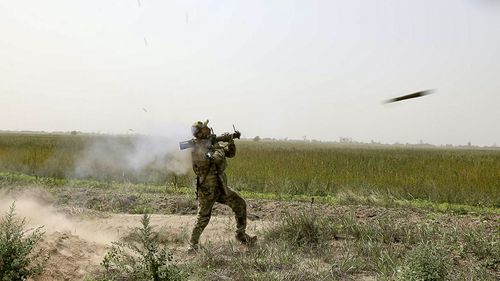A Twitter message on Monday by a government official showed jubilant Ukrainian soldiers standing by their Australian-supplied Bushmaster after fighting in the north-east, near Kharkiv.
"For the sake of protecting freedom, it travelled half the world, from Australia to Ukraine, 19,300km across the Indian Ocean," the tweet said.
The tweet said the Bushmaster helped soldiers from the 80th Air Assault Brigade advane to the Oskil River and continue to liberate the Kharkiv region from Russian occupation.
The message ended by thanking Defence Minister Richard Marles and Ukraine's ambassador to Australia, Vasyl Myroshnychenko.
The Bushmaster weighs 11 tonnes and is designed to protect its 10 occupants from land mines and other explosives.
It was widely used by the Australian Defence Force over rugged terrain during the Afghanistan conflict.

The Bushmasters were part of the Australian military aid package for Ukraine agreed by the former Coalition government earlier this year and continued by the Albanese Government.
Australia has also supplied anti-armour weapons, unmanned aerial systems and ammunition to the Ukraine government.
Heavy losses for Russia
The counterattack began in the final days of August and at first focused on the southern region of Kherson, which was swept by Russian forces in the opening days of the invasion.
But just as Moscow redirected attention and troops there, Ukraine launched another, highly effective offensive in the north-east, near Kharkiv.

Facing the prospect of a large group of its forces becoming surrounded, Moscow pulled back its troops from Kharkiv in a dramatic shift in the state of play that posed the biggest challenge to the Kremlin since it launched the invasion February 24.
“The Ukrainian army has taken advantage of the relocation of the bulk of the Russian forces to the south and is trying to direct the course of the war, excelling in manoeuvre and showing great ingenuity,” Mykola Sunhurovskyi, a military expert with the Razumkov Centre, a Kyiv-based think tank, said.
Ukraine's quick gains, he added, are “important both for seizing initiative and raising troops’ spirit”.
Ukrainian President Volodymyr Zelenskyy praised the military in a video address Saturday night, saying it has reclaimed about 2000 square kilometres of territory so far this month.
He also taunted Moscow over its withdrawal, saying the Russian army was “demonstrating the best it can do — showing its back” and “they made a good choice to run”.
The Russian military debacle has provoked outrage among Russian military bloggers and patriotic commentators, who chastised the Kremlin for failing to mobilise more forces and take stronger action against Ukraine.
Even Ramzan Kadyrov, the Moscow-backed leader of the Russian region of Chechnya, publicly criticised the Russian Defence Ministry for what he called “mistakes” that made the Ukrainian blitz possible.
Both sides have suffered heavy losses in Europe's largest conflict since World War II.
Ukraine’s military chief said last month that nearly 9000 of its soldiers have been killed in action.
And while Moscow hasn't reported its own losses since March, Western estimates put the toll as high as 25,000 dead, with the wounded, captured and deserters bringing the overall Russian losses to more than 80,000.

Ukraine has sought to mobilise the population to reach an active military of 1 million people, while Russia, in contrast, has continued to rely on a limited contingent of volunteers for fear that a mass mobilisation could fuel discontent and upset internal stability.
As the war slogs on, a growing flow of Western weapons over the summer is playing a key role in the counteroffensive, helping Ukraine significantly boost its precision strike capability.
Since the counteroffensive began, Ukraine said, its forces have reclaimed more than 30 settlements in the Kharkiv region.
In the Kherson region, troops sought to drive Russian forces from their foothold on the west bank of the Dnieper River, a potential vantage point for a push deeper into Ukraine by Moscow.
The city of Kherson, an economic hub at the confluence of the Dnieper and the Black Sea with a prewar population of about 300,000, was the first major population centre to fall in the war.
Russian forces also have made inroads into the Zaporizhzhia region farther north, where they seized Europe's largest nuclear power plant.
The last of its six reactors was shut down Sunday after operating in a risky “island mode" for several days to generate electricity for the plant's crucial cooling systems after one of the power lines was restored.
Moscow has installed puppet administrations in occupied areas, introduced its currency, handed out Russian passports and prepared for local plebiscites to pave the way for annexation.
But the counteroffensive has derailed those plans, with a top Moscow-backed official in Kherson saying the vote there needs to be put off.
The counterattack followed methodical strikes on Russian infrastructure and supply lines.
Ukrainian forces have used US-supplied HIMARS multiple rocket launchers to pound the two bridges on the Dnieper, forcing Russian troops in the Kherson region to rely on pontoon crossings that also have faced daily strikes.
Last month, a series of explosions also hit airbases and a munitions depot in Crimea, underlining the vulnerability of the peninsula that was annexed by Russia in 2014 and has been crucial for its southern operations.
Ukrainian authorities initially refrained from claiming responsibility, but the country's military chief, General Valerii Zaluzhnyy, acknowledged in recent days that his forces hit them with rockets.
Ukrainian military analyst Oleh Zhdanov said Kyiv “has used the tactics of methodically exhausting the Russian army, weakening it and depriving it of a possibility to regularly beef up its forces”.
Unlike in the south, where Ukraine's counteroffensive proceeded more slowly on the barren steppes of Kherson that left troops vulnerable to Russian artillery, the Kharkiv region's forests offered natural cover that allowed for lightning-fast surprise attacks from multiple directions.
“Swiftness and surprise have become key components of the Ukrainian army action in the Kharkiv region after Russian forces deployed there had been relocated to the south,” Zhdanov said.
Michael Kofman, an expert on the Russian military at the Virginia-based think tank CNA, said the counteroffensive “has proven a very significant victory for Ukraine".
“Russian forces appear to have been spread thinly, and military leadership unprepared despite earlier evidence of Ukrainian buildup,” Kofman wrote.
“I think it’s fair to assess that Russia was caught by surprise with little in the way of reserves locally available.”

After capturing the town of Balakliia, about 55 kilometres south-east of Kharkiv, Ukrainian forces quickly pressed their offensive farther east to Kupiansk, a rail hub vital for sustaining Russian operations in the region.
They claimed control of the strategic city Saturday, cutting supply lines to a big group of Russian forces around Izyum to the south.
To prevent their complete encirclement, Moscow ordered the hasty retreat, claiming they were relocating to focus on the neighbouring Donetsk region.
Zhdanov noted that a successful counteroffensive is key to persuading allies to further increase supplies of weapons to Ukraine, something that was discussed Thursday at a NATO meeting in Germany.
“The events in the south and in the Kharkiv region must show to the West that the Ukrainian military knows how to handle the weapons and needs to develop their success,” Zhdanov said.
https://news.google.com/__i/rss/rd/articles/CBMifWh0dHBzOi8vd3d3LjluZXdzLmNvbS5hdS93b3JsZC91a3JhaW5lLXB1c2hlcy1iaWctY291bnRlcm9mZmVuc2l2ZS1hcy13YXItbWFya3MtMjAwLWRheXMvYTMyZmNmNTItYzIzOS00MmFmLTkzZGEtM2Y5NjlkMzZiYzg40gEA?oc=5
2022-09-12 05:45:53Z
1560875820
Bagikan Berita Ini















0 Response to "Australian-supplied military vehicles help Ukrainian offensive - 9News"
Post a Comment